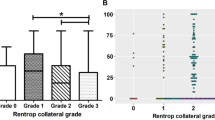Summary
Previous work of this laboratory has shown that collateral flow can be increased over six weeks by a subcritical external constriction of the circumflex artery causing a 50±10% reduction of postocclusive reactive hyperemia. To investigate collateral function in acuté myocardial infarction, the model was used to ligate two distant coronary branches on the ventricle simultaneously in order to compare in 8 dogs infarct size and perfusion area of the ligated vessels in control and collateralized sections. The acute collateral flow measured 7.2±2.5 ml/100 g/min−1 and increased to 17.3±6.7 (p<0.001) over 6 weeks. Separate analysis revealed a predominant increase of collateral flow in the epicardial layers 23.1±7.5 (p<0.01) versus 6.9±2.8 (p<0.01) in the subendocardium. Infarct size in the control area was 52.0±14.7% of the perfusion area, in the collateralized zone 19.0±14.2% (p<0.001). Infarct size expressed as per cent of perfusion area and collateral flow in the area at risk expressed as per cent of flow of normal sections correlated: (r=0.76; p<0.05). Therefore, infarct size after a 6 hour coronary occlusion can be considered a function of the collateral flow over normal perfusion ratio. Localized induction of collaterals in this model caused a significant reduction of infarct size in relation to the perfusion area at risk.
Similar content being viewed by others
References
Gottwik MG, Wüsten B, Hofmann M, Schaper W (1979) The topography of collateral growth in experimental coronary constriction. Circulation 60:II 260
Wüsten B (1979) The degree of coronary stenosis as a determinant of collateral development. In: The Pathophysiology of myocardial perfusion, Ed. W. Schaper, Elsevier/North-Holland Biomedical Press, Amsterdam New York Oxford, 453–470
Schaper W, Pasyk S (1976) Influence of collateral flow on the ischemic tolerance of the heart following acute and subacute coronary occlusion. Circulation 53/3, I-57–I-62
Schaper W, Hofmann M, Müller KD, Genth K, Carl M (1979) Experimental occlusion of two small coronary arteries in the same heart. A new validation method for infarct size manipulation. Basic Res Cardiol 74:224–229
Kalbfleisch H (1969) A method for post mortal determination of sizes of the perfusion areas of single coronary arteries (German). Z Kardiol 64:987
Sandritter W, Jestädt R (1958) Triphenyltetrazoliumchlorid (TTC) as an indicator of chemical reduction as a macroscopic diagnosis of recent myocardial infarctions (German). Verh Dtsch Ges Pathol 41:165
Schaper W, Frenzel H, Hort W (1979) Experimental coronary artery occlusion. I. Measurement of infarct size. Basic Res Cardiol 74:46–53
Schaper W (1978) Experimental coronary artery occlusion. III. The determinants of collateral blood flow in acute coronary occlusion. Basic Res Cardiol 73:584–594
Schaper W, Flameng W, Winkler B, Wüsten B, Türschmann W, Neugebauer G, Carl M, Pasyk S (1976) Quantification of collateral resistance in acute and chronic experimental coronary occlusion in the dog. Circ Res 39:371–377
Gottwik MG, Kirk ES, Hoffstein S, Weglicki WB (1975) Effect of collateral flow on epicardial and endocardial lysosomal hydrolases in acute myocardial ischemia. JCI 56:914–923
Gottwik M, Zimmer P, Wüsten B, Hofmann M, Winkler B, Schaper W (1981) Experimental myocardial infarction in a closed-chest canine model. Observations of temporal and spatial evolution over 24 hours. Basic Res Cardiol 76:670–680
Fulton WFM (1965) The coronary arteries. CG Thomas, Springfield, Ill
Meesmann W (1959) Untersuchungen zur Funktion der intra-arteriellen Koronarstenosen beim Herzinfarkt. Z Kreislaufforsch 48:193
Schaper W (1971) The collateral circulation of the heart. North Holland Publishing Co, Amsterdam London American Elsevier Publishing Co, Inc New York
Author information
Authors and Affiliations
Rights and permissions
About this article
Cite this article
Gottwik, M.G., Puschmann, S., Wüsten, B. et al. Myocardial protection by collateral vessels during experimental coronary ligation: A prospective study in a canine two-infarction model. Basic Res Cardiol 79, 337–343 (1984). https://doi.org/10.1007/BF01908034
Received:
Issue Date:
DOI: https://doi.org/10.1007/BF01908034




